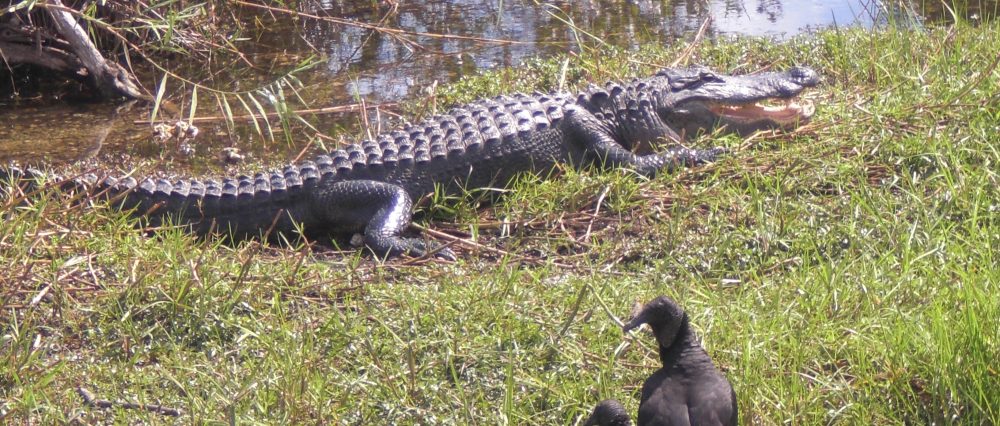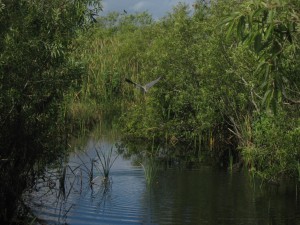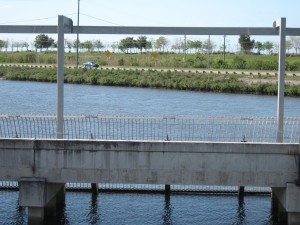“Getting the water right” is crucial for the future of the Everglades.
By Courtney Robishaw
Motorists driving along U.S. Highway 41, the Tamiami Trail in South Florida, often have to slow down or come to a stop because of ongoing construction. When they do, they likely see concrete struts supporting flat concrete blocks elevated about 10 feet in the air, stretching for one mile.
But for those who pushed for this $81 million project, they are more likely to envision something else-the original sheet flow of water once again passing across the Florida Everglades when the construction is completed.
For years people have tried to get rid of the water in South Florida. Now many are fighting for more of it. These include everyone from the cities on the South Florida coasts, the farmers, land managers in Everglades National Park, environmentalists and others.
Ever since we realized our efforts to control and tame the water in the Everglades was actually harming the fragile ecosystem, we have been trying to repair the damage. Unfortunately, this will never happen.
“It is impossible to restore the Everglades as we once knew them,” said Larry Perez, a science communications interpreter at Everglades National Park. “Fifty percent of the Everglades have now been lost, but take those remnant parcels that still remain and re-plumb the system, re-engineer it as best we can to mimic the natural timing, quantity, quality and distribution of water that mother nature originally intended.”
Historically, rainwater that began falling near Disney World in the north has flowed down the Everglades until it reached Florida Bay. The water naturally flowed south, because South Florida is essentially a slight ramp. Some have compared the elevation around Lake Okeechobee to the second floor of a two-level house, while Florida Bay’s elevation is the ground floor.
Some of that water would be caught, in the north, in Lake Okeechobee, until it periodically and naturally overflowed. The sediment in the runoff created the very fertile, “black gold” soil of the agricultural region.
Then canals, dikes and dams were built and interrupted this entire natural system. One of the barriers was the highway called the Tamiami Trail from Naples to Miami. The ongoing construction is designed to provide an outlet so that the water can again flow south into Everglades National Park.
Today the system is completely and artificially managed by the U.S. Army Corps of Engineers and the South Florida Water Management District, with influence from other groups.
“Engineers on computers are like God letting water move around,” said Neil Santaniello, a professor of journalism and former environmental reporter.
Stuart Appelbaum, chief of the planning and policy division of the U.S. Army Corps of Engineers, said management of the water in the Everglades is not easy.
“We have to think of it as one interconnected system, before trying to solve one problem without causing another problem somewhere else,” he said.
In today’s system water is released from Lake Okeechobee and it then runs through a series of canals, dikes and gates. Some of the water system, and its pumps, are huge. One pump station called the S5A is one of the oldest, built in 1955 and has one the largest capacities to pump water in the world, designed to pump a 230 square mile area.
Every Tuesday morning, the Army Corps of Engineers has a conference call with water managers, flood control specialists, farming interests, and wildlife and environmental officials to decide how much water to release from the lake into the system.
A depth of 12 feet. to 15 feet. is considered ideal for the lake, but this is only achieved one-fourth of the time. The lake is extremely shallow, no more than 10 feet in most places, and it can easily be influenced by both droughts and hurricanes.
Farmers want the lake to be deeper, since they use about a foot of water from the lake, according to Paul Gray, Lake Okeechobee science coordinator for the Audubon Society of Florida.
If water managers kept the water level of the lake too high, there is a 100 percent chance the Hoover Dike surrounding the lake would collapse, due to erosion and holes in the bottom of the dike, if the water level reached 21 feet, according to Appelbaum.
“We’re trying to balance a variety of interests and we’re in the middle,” said Appelbaum.
The ultimate solution is to complete the ongoing long-term restoration of the Everglades, which includes the work at Tamiami Trail and elsewhere. The major piece of that work is the Comprehensive Everglades Restoration Plan, signed in 2000 and now estimated to take 30 years and cost more than $13 billion. It was developed to restore the ecosystem of the Everglades and insure that there is a large enough water supply for the growing population of South Florida.
The most crucial goal of the Everglades restoration is to “get the water right,” because it is so crucial to so many different interests. If the water is not right, South Florida could become a desert, according to Lisa Jameson, a biologist at the Arthur R. Marshall Loxahatchee National Wildlife Refuge.
All of which will take time. For instance the Everglades Skyway project on the Tamiami Trail was first introduced in 1989 and it was not until 2009 that was ground broken. Now, motorists are still waiting for its completion.



